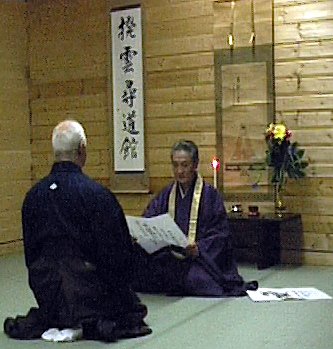Anatol,Anatol wrote:If you see "seiryoku zenyo" as a foundamental priciple of nature, it only describes, "what is" foundamental in nature (descriptive). What is foundamental in nature isn't automatically good for ethics. In nature there is the survival of the fittest, but that would be no foundamental principle for ethics, because ethics ask, what is good and righteous for individuals and for society (normativ). To go from "what is" (descriptive) to "what should be" (ethically) is a false conclusion - often done and known as naturalistic fallacy.
thanks for that clarification. I think, I now understand the type of distinction you made between "fundamental" and "universal". Of course, you're right. Initially, I was thinking you were using the two expressions rather synonym. My fault.
Agreed, yes, we (or most of us, at least) fortunately live in a society were (our) human rights are acknowledged and granted, just because we are human beings, and agreed, that rights come without obligations or duties like self-perfection or trying to be part of the perfection of society. But then, some of us start to practice jūdō, and while it is clear, that most will not know it at that moment, I think that after some time, they should know and accept those "new obligations", as, obviously, they seem to be parts of this "jūdō". It's still a decision of one's own free will, in compliance with the human rights, to engage in an activity with such goals, or not. If one does, that still doesn't deprive him of his fundamental human rights, it just imposes certain voluntary adopted duties to him.Anatol wrote:For sure it wouldn't rule out Human Rights. But if you see "jita kyoei" as a foundamental, universal ethical principle, on which you can build society (like Kano does, as I understand the Kano quotes above from noboru), there would be no Human Rights, because Human rights first and foundamental on rights of individuals only because the are human beeings. They have no duties for selfperfection, be part of perfection of society and so on.
They aren't "laws". They are ideals of something, chosen voluntarily. If somebody hates to sing, he's free to do so, and will not have to sing, in our society. However, if he chooses to join a choir, chances are, that to sing will be mandatory there, even for him. Therefore, I think he should either sing, or better leave that chorus again.Anatol wrote:If these ideals stay private and not become law, then there is no problem at all and they may be helpful in daily life.
By the way, in an earlier posting you wrote, as an answer to one of wdax's comments:
While I also prefer to live in a free society that accepts the human rights of myself and everybody else, in the meantime I think that our society has developed to a point, where a little bit more of "we" again, instead of always only "me, me, me" could absolutely be a positive thing. Not legally enforced, of course.Anatol wrote:For myself I prefer a society which is build on Individuality, Freedom, Human Rights, principle of legal certainty, democracy and no obligation of perfection in any sense. Kanos view lacks individual rights and freedom and has a strong affinity to see the individual as a part of society with lots of duties. Peace and harmony and mutual prosperity are also possible in a dictatorship whereas freedom and human rights and tolerance never can lead to repression and most times they lead to a human society and to welfare.
I didn't use the "shocked-smiley" because of that discussion, but because of my obviously poor understanding and use of English, and my also obvious lack of being able to express my thoughts clear enough in that language, in a way suitable to the principle of Sei-ryoku Zen’yō. But, you may rest assured, that, according with what I wrote earlier and you didn't read, I can live with it - sufficiently comfortable, that is.Anatol wrote:You mustn't be shocked. Thats a very old discussion between Humanists and Liberals and dates back even to antic China between Confucianists and Daoists.







